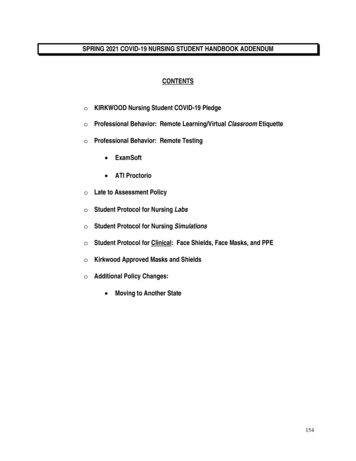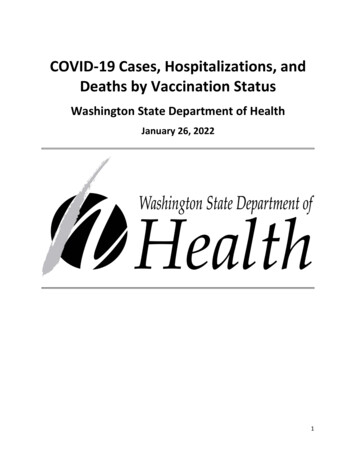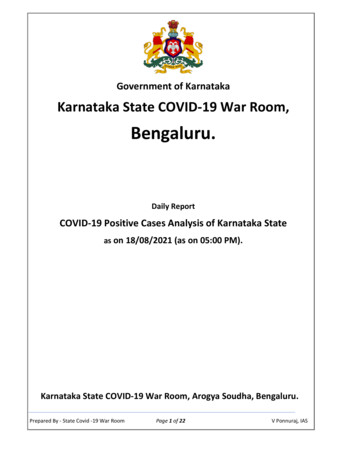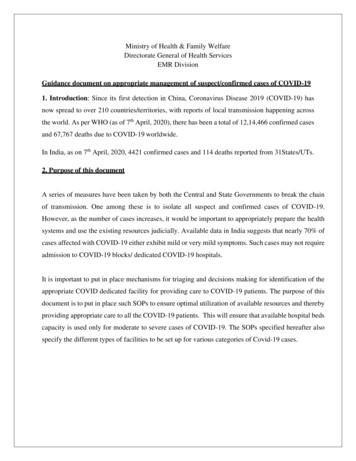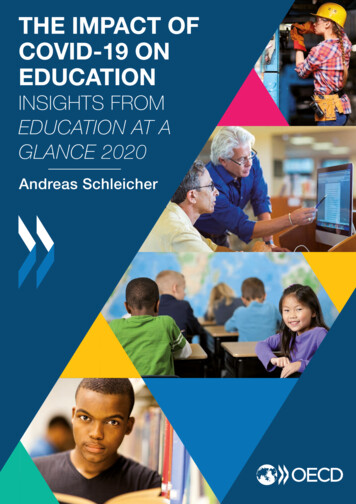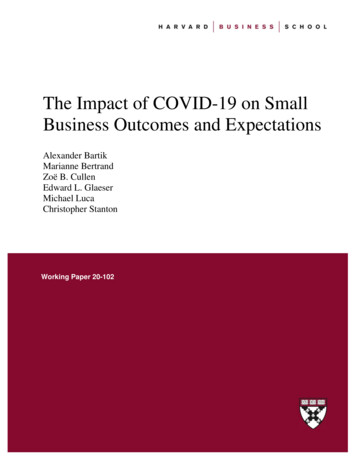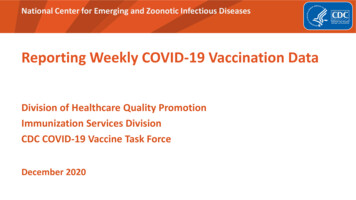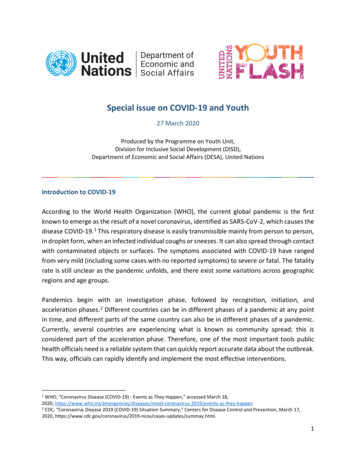
Transcription
Special issue on COVID-19 and Youth27 March 2020Produced by the Programme on Youth Unit,Division for Inclusive Social Development (DISD),Department of Economic and Social Affairs (DESA), United NationsIntroduction to COVID-19According to the World Health Organization (WHO), the current global pandemic is the firstknown to emerge as the result of a novel coronavirus, identified as SARS-CoV-2, which causes thedisease COVID-19. 1 This respiratory disease is easily transmissible mainly from person to person,in droplet form, when an infected individual coughs or sneezes. It can also spread through contactwith contaminated objects or surfaces. The symptoms associated with COVID-19 have rangedfrom very mild (including some cases with no reported symptoms) to severe or fatal. The fatalityrate is still unclear as the pandemic unfolds, and there exist some variations across geographicregions and age groups.Pandemics begin with an investigation phase, followed by recognition, initiation, andacceleration phases. 2 Different countries can be in different phases of a pandemic at any pointin time, and different parts of the same country can also be in different phases of a pandemic.Currently, several countries are experiencing what is known as community spread; this isconsidered part of the acceleration phase. Therefore, one of the most important tools publichealth officials need is a reliable system that can quickly report accurate data about the outbreak.This way, officials can rapidly identify and implement the most effective interventions.WHO, “Coronavirus Disease (COVID-19) - Events as They Happen,” accessed March 18,2020, onavirus-2019/events-as-they-happen2 CDC, “Coronavirus Disease 2019 (COVID-19) Situation Summary,” Centers for Disease Control and Prevention, March 17,2020, dates/summay.html.11
Though more demographic and epidemiological data is needed, it is known that COVID-19 caninfect individuals of all ages. However, the WHO has cautioned that older persons (and anyonewith pre-existing medical conditions such as asthma, diabetes, and heart disease) appear to bemore vulnerable to severe illness. In addition, health experts are alerting the public to thepossibility that this illness can also hit some populations with substance use disorders particularlyhard. 3 This is due to the fact that the virus attacks the lungs; COVID-19 could be an especiallyserious threat to tobacco smokers or vapers. 4 Although young, healthy individuals typically havea more robust immune system than the elderly, the WHO encourages everyone, including youth,to take extra precautions to avoid infection and transmission: Washing hands regularly, keepinga social distance from others, and staying home when sick.Social distancing is vital, not only to decrease spread but also to limit a surge in cases wherebyhospitals exceed their capacity to treat those gravely ill. That’s why many governments havecalled on youth to embrace the effort to protect themselves and the overall population. Youthare also in a position to help those who are most vulnerable, and to aid in increasing public healthsocial awareness campaigns among their communities. Thus, youth are critical and part of theactive plan to limit the virus’s spread and its impact on public health, society, and the economyat large.Socio-Economic ImpactsAlready, the global COVID-19 pandemic has led to severe economic and labour market shocks.With an estimated rise between 5.3 and 24.7 million in the number of those unemployedglobally, 5 the impact on youth employment is likely to be severe given that youth (15-24) arealready 3 times more likely to be unemployed than adults. 6 Furthermore, COVID-19-relatedshocks to the labour market are likely to impact the quality of jobs for young people, be it in theform of zero-hour contracts, informal employment, etc. Such forms of employment are markedlymore common among youth as 77 percent of employed young people hold informal jobs while126 million are extreme and moderate working poor worldwide.2 Importantly, the impact on thequality and quantity of jobs will likely disproportionately affect young people engaged in theservice sector and/or performing manual routine jobs. Young people with these jobs are also atrisk for experiencing heightened health-related hazards because they cannot work remotely.National Institute on Drug Abuse, “COVID-19: Potential Implications for Individuals with Substance Use Disorders,” March 12,2020, substance-use-disorders.4Ibid.5ILO (2020), 'COVID-19 and the world of work: Impacts and responses6ILO, Global Employment Trends for Youth 2020, p.13, rts/---dcomm/--publ/documents/publication/wcms 737648.pdf32
Measures to ease the financial burden of youth have taken multiple forms thus far, but they arenot enough to address the full breadth of the pandemic. From changes to statutory sick pay totax deferrals, company loans, cash bonuses, and more, the measures the world is takingencompass working populations as a singular group and need to be further expanded. China’sactions, for instance, only reflect the uncertainty surrounding the duration of the pandemic withall measures in effect up to 3 months after its resolution. Subsequent outbreaks around the worldprimarily address changes to income support schemes. Across all measures reported so far, auniversality exists: Their temporality. Whilst short-term financial support is needed, the differinglevels of impact and a long-term strategy should be considered. For example, promoting anarrative of opportunity may ease the transition into a post-pandemic economy; to learn how toengage youths in a work culture in flux is just one way to work toward increasing the economy’sresilience.The global COVID-19 pandemic is also having an unprecedented impact on education systems allover the world with far-reaching social consequences. According to UNESCO, 165 countries haveso far (as of March 27) implemented nationwide closures of educational institutions, and severalmore have implemented localized ones, in total affecting 1.52 billion of children and youth. Thisnumber represents over 87 percent of all enrolled learners and is expected to increase further asthe pandemic spreads and more countries enforce nationwide closures. 7 Moreover, the durationof these closures is highly uncertain.The situation can be expected to have severe consequences in terms of interrupting learning,compromising nutrition, and elevating drop-out rates. In particular, the closures aredisproportionately impacting disadvantaged and underprivileged children and youth who havefewer educational opportunities outside of school, a lack of access to remote learning tools andthe Internet and rely on free or discounted school meals for healthy nutrition. With protractedclosures, it will become a challenge to ensure that students return to school once reopened. Toalleviate the situation, governments should ensure there is continuity in learning by promotinghigh-tech, low-tech and no-tech solutions, focusing in particular on reaching vulnerablegroups. 8 In addition, international cooperation to share best practices on effective responses willbe instrumental.UNESCO ”COVID-19 Educational Disruption and Response” /coronavirus-schoolclosures8UNESCO “Half of world’s student population not attending school: UNESCO launches global coalition to accelerate deployment of remotelearning solutions” l-coalitionaccelerate73
Another area of impact is on young migrants and refugees. Given 70 percent of all internationalmigrants are below 30 years of age globally 9 and in 2019, 38 million international migrants werebelow the age of 20 years, 10 epidemics such as COVID-19 are likely to disproportionately affectthis population. Furthermore, out of about 100 countries affected by COVID-19, 34 have arefugee population of more than 20,000 who are at very high risk 11 as they often live inprecarious living conditions. This group gets left behind in the provision of healthcare whennational systems' capacities are overstretched due to COVID-19. There is also a risk COVID-19may further stigmatize migrants and refugees or increase xenophobia and racism, which in turnmay further affect the ability of young migrants and refugees to receive healthcare and maintaintheir livelihoods.Social Policy Responses to COVID-19Whilst the public health response to COVID-19 is ongoing, a number of other social policyresponses are also necessary as the crisis of COVID-19 expands to socioeconomic spheres of life.Social protection systems are one major way in which governments aim to mitigate some of theimpacts that COVID-19 is having on people’s wellbeing and livelihoods.However, access to social protection varies significantly depending on a person’s background,including age, and this can further exacerbate vulnerabilities of young people. Too often, thespecific needs of young people, stemming from this unique transition period between childhoodand adulthood, are not properly considered in social protection systems. This includes youngpeople who miss out on child- or family-based social protection systems but do not yet haveaccess to employment-based social protection. These gaps in access can adversely impact youngpeople’s lives and generate negative consequences that can be felt in the long term and evenspill over across generations.In the current COVID-19 pandemic, inclusive social protection is even more vital to protect youngpeople who are already, in normal times, at a higher economic and social risk. Because youngpeople are disproportionately affected by unemployment, the COVID-19 pandemic will likelydrastically increase unemployed youth, a population already overrepresented in the informaleconomy (around three quarters of young workers are in informal employment around the2019 International Migration and Displacement Trends and Policies Report to the G20 10UN DESA (2019), International Migration 2019 Report, New York11UNCHR The Refugee Brief (blog), March 11, 2020, ef-11-march-2020/.94
world). 12 As many social insurance programmes are linked to formal employment, that leavesmany young people, especially young women, underserved or unserved.The labour market disadvantages faced by young people also affect their access to other socialprotection schemes like health insurance. Many young people in countries where universalhealth coverage is not available are either unemployed, informally employed, or among theworking poor. As such, they have neither health insurance nor the means to cover additionalhealth-related expenses. Therefore, a large portion of young people will not have access to healthcare and services necessary to treat and prevent COVID-19. Moreover, homeless and unbankedyouth are at even greater risk and must be included in national social protection systems.As member states initiate emergency fiscal measures to expand social protection as a responseto COVID-19, it will be important to ensure that their system includes all youth in their socialprotection measures.Youth Responses to COVID-19COVID-19 affects all segments of the population, with young people playing a key role in themanagement of this outbreak and the recovery following the outbreak. Though much is stillunknown on how the disease affects young people, governments are mandated in theWorld Programme of Action for Youth (WPAY) to ensure their services meet the needs of youngpeople. In these circumstances, it is important to ensure that youth are heard alongside othercommunity and patient voices in the rollout of health and non-health interventions in responseto COVID-19.Building up the capacity of youth to be able to make their own decisions on health and to takeresponsibility for health is also a key element of WPAY. In this context, health education, publichealth promotion, and evidence-based information are critical in combating the spread andeffects of COVID-19, especially to challenge the spread of disinformation online. The role ofgovernments as well as youth organizations and community groups will be essential to ensurethat trustworthy public health information is disseminated. Young people themselves arealso utilizing online technologies to spread public health information in engaging ways such asvideos to promote effective handwashing or explain how social distancing can save lives.Young innovators are already responding to the virus through social impact innovation. Aroundthe world, a number of initiatives are being developed to leverage young people’s efforts to12UN DESA, World Economic Situation and Prospects, April 2019 briefing, no 123.5
generate and deliver support to at-risk populations or populations affected by the pandemic.Whilst most of these initiatives are on a voluntary basis (e.g. young people offering to shop forand deliver food to elders or at-risk people), they can also take the shape of social enterprises.Many youth-driven technology innovation hubs are supporting startups to develop effectivesolutions to address COVID-19. For example, CcHUB (an open living lab and pre-incubation space)in Nigeria is offering to provide financial, research and design support for projects related toCOVID-19.Conclusions and RecommendationsIn a little over 3 months, COVID-19 has morphed from a small outbreak to a pandemic, which theWHO deems a public health emergency of international concern and a socioeconomic crisisaffecting everyone. Whilst epidemiologists are still analyzing the devastating health impacts onyoung people and their families, indicators suggest there will be widespread economic and socialimpacts on their communities and economies. Governments and the UN System mustunderstand and anticipate these impacts so the worst effects of this crisis can be avoided.The priority remains a vigorous and global public health response that interrupts transmissionsand provides effective care and treatment for those who are positive. In this effort, youth canplay a key role in supporting the public health response by taking responsibility for their healthbased on the best available evidence and information.However, the economic and social impacts also present challenges for Member States. Youngpeople are already disproportionately unemployed. And for those who are employed, many workin the informal economy, gig economy, on precarious contracts or in service sectors of theeconomy that are likely to be severely affected. More than one billion youth are now no longerphysically in school. Vulnerable youth such as migrants and refugees or homeless may fare evenworse. This could lead to unprecedented levels of unemployed youth and education or trainingrequiring robust social protection expansions.Overall, the COVID-19 pandemic calls for global solutions and intergenerational solidarity, andfor innovative, inclusive policy solutions. The Sustainable Development Goals will be moreimportant than ever in accelerating the response and recovery of this epidemic 一 as well as buildthe resilience and "social immunity" that the world needs to combat the next pandemic. Thefollowing recommendations are put forward for the consideration of Member States and UNentities:6
Provide universal health coverage, including all young persons, and ensure that the healthsystem effectively meets the needs of youth in COVID-19, including public health promotion,testing and treatment.Promote public health approaches and accurate information so that young people can beempowered to make evidence-based decisions on their health.Monitor youth unemployment and underemployment, take targeted measures during therecovery to promote youth employment and decent work.Adapt the delivery of education, through digital and non-digital methods, from earlychildhood education to tertiary education to ensure the continuation of skills acquisition andlearning.Protect the rights of migrants, refugees and other minority youth during this epidemic,including right to health care, and combat the rise of xenophobia and racism resulting fromthe spread of COVID-19.Ensure that social protection systems include all young people, with special attention paid tothose who are most vulnerable and marginalized, such as homeless youth, youth withdisabilities, unbanked youth, etc.Consult and meaningfully engage youth in the development of health, economic, and socialinterventions in response to COVID-19 and in its recovery.Incentivize youth innovation for the prevention and treatment of COVID-19 and themanagement of its corollary socioeconomic impacts.For more information, please contact: Ms. Nicola Shepherd, Chief, Programme on Youth Unit,DISD, UN DESA, at shepherdn@un.org7
1 . Special issue on COVID-19 and Youth . 27 March 2020 . Produced by the Programme on Yout



